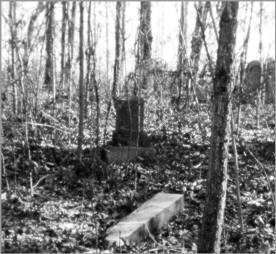

By SCOTT AKRIDGE, June 2004
For the last several months, volunteers have been working to clean up Crow Cemetery. This site near Kensett was the largest overgrown cemetery in White County. Hugh Akridge of Kensett is coordinating the effort with assistance from Bill Leach of the White County Historical Society. Crow Cemetery is significant for several reasons. First, the earliest birthdate found on a tombstone in White County is located here. Elder William West was born in 1775, though not in White County. Second, the only known tombstone in the county of an African-American Civil War soldier is here as well. Private Nicholas Owens of the 113th Regiment, United States Colored Troops enlisted in 1863 and was discharged at the end of the war. Third, this cemetery predates the founding of Kensett by more than 30 years. Thus numerous pioneers significant to early county history are buried here. Fourth, the cemetery is located just east of where the Battle of Whitney's Lane took place, in 1862. No one killed in the battle is known to be buried here but some of the landowners associated with the area at the time are buried here.
Crow has long been thought of as two separate sections – the well-kept modern part where African-American deceased are buried and the older, heavily overgrown part that was thought to be only whites. This thinking is being challenged by discoveries as the cemetery is being cleared. The overgrown section has family names such as Whitney, Crow, Hart, Mitchell, Owens, Hamilton, Black and others. We first thought that these were white families only, several of whom were slaveholders. The discovery of the Nicholas Owens stone in the back portion conflicted with our thinking. Then it was discovered that a child belonging to Levi Whitney was buried here. Census records do not show a white Levi but apparently there was a black Levi. Thus we have discovered that the overgrown portion of the cemetery contains the graves of whites and blacks. This is really not a surprise. I had long maintained that since slaveholders were buried here then slaves were buried here as well even though their graves are unmarked. Since the earliest marked grave in the overgrown part is 1852 and the earliest marked grave in the well-kept modern part is 1913 we must no longer think of this cemetery as being racially divided but think of it only in terms of the older part and the newer part. The vast majority of graves in the overgrown section are not marked in any way. They are visible only by depressions in the ground. There are a number of graves marked with only rocks. Tombstones were apparently a luxury as so few graves have them. Estimates of the number of graves in the overgrown portion range from 200 to 400. In the back part of the cemetery is a remnant of a wagon road. The "cut" for this road is as much as three feet deep. We believe this could have been the original Searcy to West Point Road dating perhaps as early as the 1830s. This section was likely abandoned around the time the nearby railroad was built in the 1870s.
The cleanup has created large piles of limbs, and the Kensett Fire Department plans to burn these piles once all the brush has been cleared from the cemetery. Neighboring landowner Jim Mobley has graciously allowed the use of his pasture for the purpose of piling much of the debris from cemetery cleanup. Bill Leach has allowed several of the community service workers to be pulled away from work at Pioneer Village to help with the cleanup of this cemetery. Members of the Kensett Volunteer Fire Department and the Woodmen of the World have donated time to the cleanup effort. Cleanup continues each Saturday beginning around 7:30 a.m. and continuing until noon. Some days we have had as many as 12 workers but usually there are only four or five. Anyone wanting to volunteer is welcome as are donations to help with the costs associated with the cleanup. We are currently in need of a walk-behind brush cutter and a stump grinder. Anyone wanting to donate the use of these items will be gratefully acknowledged. Crow Cemetery is located one mile north of Kensett on Whitney's Lane and one-quarter mile east of the railroad. Contact Hugh Akridge at 742-3329 or Bill Leach at 268-1100 for more information.
VVV
(The writer is a member of the White County Historical Society and former president of the Arkansas Archeological Society.)